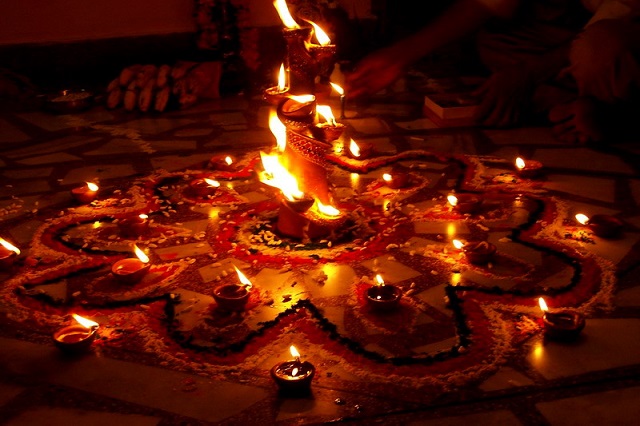Diwali, the Festival of Lights is celebrated grandly everywhere in India. The multi-cultural country has numerous legends associated with it. Every region of the country has unique ways to celebrate the festival. Find out 15 unique ways in which Diwali is celebrated across India:
Maharashtra worships the holy cow first
Given the status of holy to India’s most loved animal cow, the country looks for excuses to worship this milch animal and in some way or the other succeed in doing so. But who would have thought that the festival of lights, Deepavali too has some meaning for the animal. This happens in the Marathi dominated state of India, Maharashtra where the celebrations of Diwali start early; not with oil lamps or crackers, but with a ritual for the holy cow they call the Vasu-Baras.
Symbolizing the love of a mother towards her baby, a Hindu prayer (Aarti) is performed for the cow and her calf at every home of the state. On this day, people keep a special kind of fast in which they partake only a single meal for the day. The whole idea behind going different from the rest of India during Diwali is it is believed, largely by the Marathis that during the auspicious time of Diwali, the environment gets filled by a lot of spiritual energy, which further causes disturbance. In order to balance it up, this cow ritual have to be performed through which the energy of Lord Vishnu is channelized for the spiritual stability of the ambience.
Orissa- Poles of Bamboo to lighten the path to heaven
Travel to Orissa during Diwali and you will find tall bamboos tied erected in front of the households. Each of these bamboos usually have an earthen pot tied to it which is further raised to a height by using a rope. On the inside of the pot is kept a lamp; thereby giving the whole structure a resemblance of a street lamp. The reason why they do it? Well, people of Orissa believe that by lightning the dark paths in this fashion will help the spirits of their dead ancestors find a way to the heaven.
This tradition is in existence in the state since the very old times, even though the modernity illuminates the houses with multi-colored lights and bulbs.
Diwali starts with prayers to Goddess Kali in West Bengal
Though the whole of India worships Goddess Lakshmi on Diwali, West Bengal residents, Bengalis worship Maa Kali. Diwali is a two day affair for people here. Laxmi Pooja celebrated in rest of the country has been earlier celebrated here. 5 days after the festival of Dusshera on a full moon day, the Goddess of Wealth has been already been worshipped.
As Diwali is celebrated on the new moon day, Amavasya, the fierce Devi Kali is worshipped. In the same pandal where Goddess Durga was worshipped few days back, the stage is now the ‘Goddess of Destruction’ so that new beginnings can happen. The festivities are the same. Earthen lights, electrical lighting and firecrackers light up the skies. The devotees of Maa Kali fast the entire day. Some fast without water the entire day. The next day feast of delightful sweets and traditional food is available.
Goa burns demon effigies on Diwali
 |
| Diwali at baga beach,Goa |
Amongst the various events and festivals that take place in Goa during the time of winters, Diwali is highly prominent. Goans have an altogether different theory from the main mythology that revolves around this festival. As per the legend, Lord Krishna killed a demon king, named Narkasur, on this very day by slaying his head with the Sudharshan Chakra. In honor of such an event, every year during the time of Diwali, people of Goa publically burn the effigies of the demon king Narkasur. Rest of the celebrations stay the same as in the rest of India; cleaning of the houses, decorations with traditional lamps, lights and fireworks.
Assam - Diwali Heralds New Wealth
 |
| Image Source: commons.wikimedia |
Diwali in Assam is a grand festival. The state worships the Goddess of Wealth and prosperity. Prayers, diyas, aartis and Rangoli are the beautiful allures. Not only the homes are beautified to welcome the Goddess, every road every nook and corner is illuminated. Businesses worship the book of accounts in this day so that prosperity continues. New wealth is heralded in the auspicious festival. New things are brought. Old and broken things are dispatched from homes. Like the other regions of the country, firecrackers lighten up the skies. Mithai and warm greetings are exchanged.
A 'Choti' Diwali before the main day in Bihar
People in Bihar follow the tradition of celebrating a smaller version of Diwali, just a day before the main festival. Known as Choti Diwali, celebrations of this day are marked by fewer lights and crackers are fired as compared to the main day. Devotees usually observe a day long fast, which gets over only after sunset. 21 diyas are lighted on choti Diwali. The day of Diwali starts with a holy snan in River Ganga. The evening starts with the worship of Goddess Lakshmi. Lights, Rangoli, sweets an firecrackers are the allures. The homes can be seen twinkling with millions of diyas and electronic lights in all shapes and clouds hung.
Jammu & Kashmir – Don’t Forget To Visit Dal Lake in Srinagar
Jammu and Kashmir celebrates the Festival of Lights in their own charming way. The Kashmiri Pundits celebrate the festival grandly. The homes are lighted up. People have cleaned their homes. Thrown away the broken and unwanted things. Prayers have been offered to the Goddess of Wealth. Sweets, dry fruits and traditional delicacies are exchanged. Diwali is incomplete in the heavenly mountain state without a mention of Dal Lake. The beautiful Dal Lake in Srinagar is seen lighted up with millions of diyas floating on the waters. The glittering lights, the snowcapped mountains in the background and the peaceful ambiance are the perfect elements of a chersihed memory.
Double festivity at Golden temple in Amritsar (Diwali/Bandi Chhor Diwas)
If you are looking for an enormous show of lights, head to Amritsar in the state of Punjab during Diwali. The city’s main attraction, the sacred and graceful Golden temple gets all covered in jubilant lights and traditional lamps, making the sight a perfect behold. Having said that, the Sikhs have another reasons for such a decoration of the sacred Gurudwara, other than Diwali.
It’s the anniversary of the release of the 6th Sikh Guru, Guru Hargobind Ji along with 52 other prisoners (Hindu Rajput princes) from the Gwalior fort, which is known as ‘Bandi Chhor Diwas’. Looking at the ample decorations by traditional lamps and lights during the occasion, some might fail to separate the two festivals. However, it is important to understand the significance of this festival as it overshadows the spirit of Diwali in some way at the Sikh dominated city of Amritsar. Put it anyway, glittering beautiful lights, firecrackers and feasts is the essence of both the festivals.
Race for the title of the best decorated market in Rajasthan during Diwali
Vibrancy of Rajasthan use to be at its prime during the time of festivals. One such occasion is the festival of lights; Diwali, which is celebrated in a unique fashion at this colorful state. The prime cities of Rajasthan like Jaipur and Jodhpur gets all dazzled up with colorful lights and decorations, Where ever one sets his sights on, a rumble between glittering artificial as well as traditional lights can be seen.
Not to forget the crackers which resonate the whole environment and symbolically banish the evil off the streets. The festive crescendo highlights a big shopping festival in the pink city. The festival invites many small and big markets of Jaipur in which they strive to be the best decorated one. Offering a plethora of items; traditional, decorative, household and apparels, these markets are set at different locations of the city like the Vaishali Nagar, Jayanti Bazaar, Chandpole Bazaar, Chaura Rasta and Raja Park. With so much festive exuberance, Diwali is surely a carnival festival in Rajasthan.
[ Read More About Fairs and Festivals in Rajasthan ]
Himachal Pradesh - Where Tales of Ramayana Are Narrated & Performed
Hindu mythology explains the festival of Diwali as the occasion when Lord Rama along with his wife Sita and brother Laxman returned to his home land Ayodhya after completing a long term of exile. All this along with the complete story of Lord Rama and his fight with the demon king Ravana is mentioned in detail in Ramayana. Thus, getting themselves completely devoted towards the great Lord are the people of Himachal Pradesh, where tales from the Ramayana mythology are narrated and enacted in the form of a play. This resembles a lot to the celebrations of Dusshera; Ramlila, in North India.
Oil bathing customs in Tamil Nadu
Tamil Nadu celebrates Diwali a day earlier than the date available for the whole nation. This is because of the traditional Tamil calendar that links this festival with the month of Aipasi (thula). Well, the point here is not about the date, but the unique way in which Diwali is celebrated here.
Preparations start a day before, owing to which people clean their ovens. A coating of lime is put on the ovens and then the containers are filled with water for the next day’s oil bathing ritual. On the festival day, families wake up very early to have an oil bath before the sunrise. The belief following this custom says that it is equivalent of having a bath in the holy Ganges. Elderlies apply Gingelly oil on the head of the younger members of the family, which then culminates into a full body oil bath. Some natives of the state also apply a medicinal ayurvedic paste, known as ‘Deepavali Lehiyam’ right after the oil bath. After the completion of this unique ritual, partake of a hearty breakfast of sweets and various other South Indian dishes takes place. Crackers and the other usual celebrations of Diwali follow later.
Delhi’s perfect festive moods!
Delhi, the multi-cultural capital city of India celebrates numerous festivals of different religions and ethnicities in full enthusiasm and gaiety. One prominent amongst them is the Hindu festival of Diwali. The capital does not wait for the festival date, rather the festivities of Diwali start three weeks before; right after the Dusshera festival. Right from that day, the capital sets a trend of shopping; discounted sales and promotional offers.
As the days of the festival are considered auspicious for buying new items; apparel, furniture, jewelry, all the popular shopping joints of the country get crowded with people. Besides, the evenings at some corners of the city are meant for staging the tales of Ramayana. The main day of the festival is meant for Laxmi Pujan, which people at their homes and offices perform with proper devotion. Unique thing about Diwali celebrations in Delhi is that it grips all the people irrespective of the difference in the caste, religion and community in one thread of festivity which in turn illuminates the whole city like a newlywed bride.
Diwali gets a sacred touch at Varanasi, Uttar Pradesh
Varanasi in the state of Uttar Pradesh is one of the very few places in India that knows how to manage religion. In other words, the city is the core of Hindu religion in India. Owing to such significance of this place, it is not hard to guess the picture of the Diwali night here.
A true visual delight, Diwali celebrations at Varanasi are highlighted the best at the city’s sacred Ghats. Thousands of brightly lit earthen lamps mark the decorations of the river lines. Look them from a height and they resemble golden stars devoting their lights completely to the Ghats. Little away from the river line are the enactments of Ramayana, locally known as Ramlila goes on. Adhering to professional actors, these Ramlilas are certainly amongst the best in India. Such an infusion of religion, devotion and art, makes Diwali at Varanasi highly unique.
Gujarat - Celebrating New Beginnings with Family and Friends
In Gujarat, Deepavali is the festival that brings together families, friends and religions. The festivities are five days long. Every home, from the hut of the poor to the mansion of the rich is lit with twinkling diyas. Lakshmi, Goddess of wealth and prosperity is welcomed. Floral decorations, fireworks and rangoli add grandeur to this festival. The five days of Deepavali are Dhan Terash, Kali Chaudasa, Diwali, Padva or Varshapratipada (starting of Vikram Samvat, New Year) and fifth day is Bhai Bij. Seventh day is the auspicious day for any good things to begin. Like the whole nation, Gujarat celebrates with New Year shopping spree, cleaning homes, preparing dishes, wearing new clothes, bursting crackers and exchanging greeting.
Madhya Pradesh
Madhya Pradesh like the whole of India has a multi-ethnic population. Lying in the heart of India, the state has a dominant population of tribals. The tribals celebrate Diwali in their own charming way. From their attires, huts, dance and songs, the festivities are a kaleidoscope of colors. The melodies of their songs are pleasing. The cleaning of homes, worshiping, and exchange of gifts are similar to other parts of India. The festivities in the tribes are carried out in their own manner. Some of the activities that people indulge in are cock fighting, drinking, carefree revelry, dancing and singing. The customs may differ but the feeling of peace, new beginning and unity are felt throughout the country.
[ Read more about Diwali Festivals in India ]
Related Post:

























